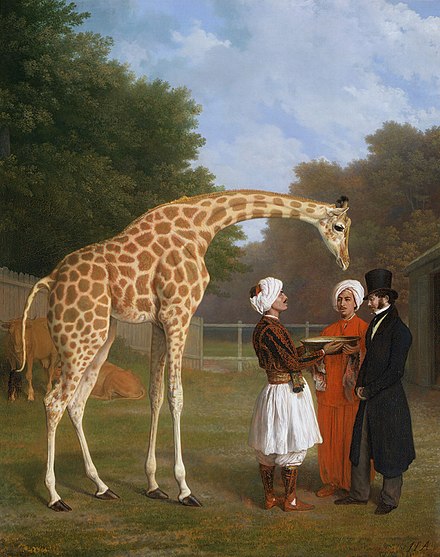

Edward Cross ( bautizado el 3 de febrero de 1774 - el 26 de septiembre de 1854) fue un propietario de un zoológico y comerciante de animales inglés .
Cross nació en Londres y fue bautizado en St Andrew's, Holborn , presumiblemente a los pocos días de su nacimiento. Aparte de los nombres de sus padres, Walter Cross y Jane (de soltera Callow), sus primeros años de vida siguen siendo oscuros. Se casó con María Herring. [ ¿cuando? ]
Cross trabajó para Stephen Polito , el propietario de la casa de fieras de Exeter Exchange en Strand . La hija de Cross se casó con el hermano de Polito, y Cross compró la casa de fieras después de la muerte de Polito en 1814. La casa de fieras había estado operando en ese sitio desde 1773 en competencia con la Royal Menagerie en la Torre de Londres con leones, tigres, monos y otras especies exóticas. todos confinados en jaulas de hierro en pequeñas habitaciones. La colección de animales era principalmente una atracción para visitantes abierta al público en general. Fue visitado por Wordsworth y Byron , este último registró viendo a los "tigres cenar", divirtiéndose por el cariño de una hiena hacia su cuidador, y las bromas que hacía un elefante con su trompa. [1]
Los animales de la colección fueron pintados por Edwin Landseer y Jacques-Laurent Agasse . También fue visitado por científicos como Joshua Brookes y JE Gray . Gray nombró al Rhinoceros crossii en su honor (ahora como sinónimo del rinoceronte de Sumatra , Dicerorhinus sumatrensis ). [2]

Cross renamed the collection the Royal Grand National Menagerie, and employed a doorkeeper who was dressed as a Yeoman of the Guard. The living conditions for the animals were so poor that negative comments were made even in the early 19th century. The situation became untenable after his elephant, Chunee, became unmanageable and killed a keeper. Chunee was finally put down by a firing squad of soldiers from Somerset House on 1 March 1826. Cross attempted to sell the collection to the new Zoological Society of London in 1826 and 1828, but the offer was refused on both occasions.[citation needed]
The Exeter Exchange was demolished in 1829, as part of general improvements to the Strand, and Cross moved the menagerie to the King's Mews near Trafalgar Square (now the site of the National Gallery). Some of the animals were sold to the new London Zoo in Regent's Park. In 1831, he sold the remaining animals to the Surrey Literary, Scientific and Zoological Institution – an institution that he had founded - for £3,500. Cross became superintendent of the new Surrey Zoological Gardens, and the animals were moved to Royal Surrey Gardens, in the grounds of Walworth Manor House in Kennington. Many of the exotic animals were housed in a large circular domed glass conservatory, 300 feet (90 m) in circumference with more than 6,000 square feet (600 m2) of glass. The collection expanded in the following years to include lions, tigers, an Indian rhinoceros, an orang-utan, and several giraffes.
Cross retired in 1844, and he died in Kennington in 1854. His wife, Mary, had predeceased him. The zoo became run down after Cross retired, and the animals were sold off in 1856, to be replaced by Surrey Music Hall.[citation needed]